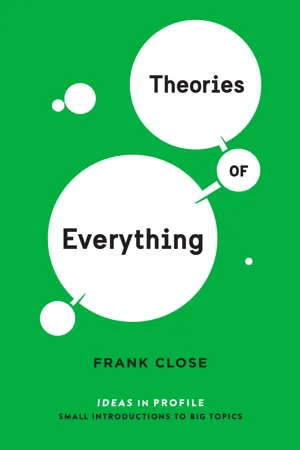
- English
- ePUB (mobile friendly)
- Available on iOS & Android
Theories of Everything: Ideas in Profile
About this book
Physicist Frank Close takes the reader to the frontiers of science in a vividly told investigation of revolutionary science and enterprise from the seventeenth century to the present. He looks at what has been meant by theories of everything, explores the scientific breakthroughs they have allowed, and shows the far-reaching effects they have had on crucial aspects of life and belief. Theories of everything, he argues, can be described as those which draw on all relevant branches of knowledge to explain everything known about the universe. Such accounts may reign supreme for centuries. Then, often as a result of the advances they themselves have enabled, a new discovery is made which the current theory cannot explain. A new theory is needed which inspiration, sometimes, supplies. Moving from Isaac Newton's work on gravity and motion in the seventeenth century to thermodynamics and James Clerk Maxwell's laws of electromagnetism in the nineteenth to Max Planck's and Paul Dirac's quantum physics in the twentieth, Professor Close turns finally to contemporary physics and the power and limitations of the current theory of everything. The cycle in which one theory of everything is first challenged and then replaced by another is continuing right now.
Frequently asked questions
- Essential is ideal for learners and professionals who enjoy exploring a wide range of subjects. Access the Essential Library with 800,000+ trusted titles and best-sellers across business, personal growth, and the humanities. Includes unlimited reading time and Standard Read Aloud voice.
- Complete: Perfect for advanced learners and researchers needing full, unrestricted access. Unlock 1.4M+ books across hundreds of subjects, including academic and specialized titles. The Complete Plan also includes advanced features like Premium Read Aloud and Research Assistant.
Please note we cannot support devices running on iOS 13 and Android 7 or earlier. Learn more about using the app.
Information
Table of contents
- Copyright Page
- Contents
- Chapter 1. Lord Kelvin’s Hubris
- Chapter 2. What is a theory of everything, and what is ‘everything’?
- Chapter 3. Newton’s theory of inanimate tortoises
- Chapter 4. Quantum theories of small things
- Chapter 5. Weighty matters
- Chapter 6. The clouds of quantum gravity
- Chapter 7. Back to the future
- Notes and references
- Further reading
- Acknowledgements
- Index